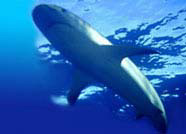


Shark Glossary

 |
 |
 |
|||
| Home | Evolution
| Classification
| Glossary | Biology
| Behavior | Shark
Repellent | Shark
Conservation | Do's &
Don'ts | Did You Know?
Shark Glossary |
 |
||||
|
Van Rooyen's Shark
Carcharhinus leucas is also known as the Bull shark, the Ganges shark, the River shark, the Cub shark, the Zambezi shark, the Shovelnose shark, the Slipway gray shark, the Square-nose shark, and the Nigaragua shark. It is a large, fierce predator that eats fish, including other sharks, ray, and just about anything else. It has been known to attack people and will venture into fresh water. Viviparous Viviparous animals are born live and do not hatch from eggs. Some sharks are viviparous. Weasel Sharks Weasel sharks (Hemigaleidae) are a member of the order: Carcharhiniformes (ground sharks). The weasel sharks include the Hooktooth shark (Chaenogaleus macrostoma), the Sickelfin weasel shark (Hemigaleus microstoma), the Snaggletooth shark (Hemipristis elongatus), the Atlantic weasel shark (Paragaleus pectoralis), and the Straight-tooth weasel shark (Paragaleus tengi). Whale Shark Rhincodon or Rhiniodon typus is the largest shark and the largest fish. It is up to 46 feet (14 m) long and weighs up to 15 tons. It is a filter feeder and sieves enormous amounts of plankton to eat through its gills as it swims. Order Orectolobiformes.  White
Shark White
SharkCarcharodon carcharias a large oceanic predator, up to 23 feet (7 m) long, weighing over 7,000 pounds (3200 kg) It has 3,000 teeth and eats pinnipeds (sea lions and seals), small toothed whales, otters, and sea turtles. (Order Lamniformes) Whitetip Reef Shark Triaenodon obesus is a gray requiem shark with obvious white tips on its dorsal fin and tail. It is not closely related to the oceanic whitetip shark. It can grow to be about 7" (2.2 m) long, but is usually smaller, about 5 1/4 feet (1.6 m) long. It is a sluggish, slender, and potentially dangerous bottom feeder, hunting at night in reefs. It favors depths of 26-130 feet (8-40 m). It has pointed teeth flanked by cusps. They rest by day, frequently in caves or under rock or coral outcroppings. They are viviparous and have litters of 1-5 pups (20-24" inches or 60-50 cm long) after a 5 month gestation period. It is a common shark and is found in the Red Sea, the Indian Ocean, the central Pacific Ocean and the Tropical eastern Pacific. (Order Carcharhiniformes , Family Carcharhinidae. Wobbegong  Wobbegongs are common, flattened sharks that live on the sea bed. They have an anal fin, 5 gill slits, 2 dorsal fins, no fin spines, mouth in front of the eyes, and powerful jaws. Many wobbegongs are camouflaged to blend in with their sea bed environment. These nocturnal sharks eat invertebrates and fish. The different varieties of Wobbegongs vary in size, but the largest are up to about 13 ft (4 m) long. Some wobbegongs (like the Ornate Wobbegong and the Tasseled Wobbegong) have been known to attack divers who stumble upon it. Wobbegongs bear live young. (Classification: Order Orectolobiformes , Family Orectolobidae, Genera Eucrossorhinus, Orectolobus, and Sutorectus). Zambezi Sharks Carcharhinus leucas is also known as the Bull shark, the Ganges shark, the River shark, the Nicaragua shark, the Cub shark, the Shovelnose shark, the Slipway gray shark, the Square-nose shark, and Van Rooyen's shark. It is a large, fierce predator that eats fish, including other sharks, ray, and just about anything else. It has been known to attack people and will venture into fresh water.  Zebra
Bullhead Shark Zebra
Bullhead SharkHeterodontus zebra is a bottom-dwelling shark that grows to 4 feet (1.2 m). This shark has a blunt head and large knobs above each eye; there is a small spiracle behind and below each eye. This shark has black stripes that give it its name. There are 2 large dorsal fins (each with a spine). The Zebra Bullhead shark is found in in the western Pacific Ocean, off Australia, Indonesia and east Asia. This bottom-dweller eats small invertebrates from the sea floor. This shark is oviparous (egg laying), producing eggs in big, screw-like egg cases. Very little is known about this shark. Classification: Order Heterodontiformes, Familiy Heterodontidae (Bullhead or Horn sharks), Genus Heterodontus, Species H. zebra (named by Gray in 1831). Zebra Shark  Stegostoma fasciatum is a common bottom-dwelling shark that grows to 11.5 feet (3.5 m). Although the young have zebra-like stripes (yellow on black), adults have leopard-like patterns (brown spots on tan) on their upper surface. Barbels (whisker-like feelers) flank its nostrils. It has small eyes, a small mouth, a shin, flexible body, and a tail fin with a broad, elongated upper lobe. This sluggish shark is harmless to people and eats crustaceans, shellfish, and small fish. It lays brown to black pouch-like eggs (5 - 7 inches, or 13 - 18 cm long) with hairy filaments that anchor the eggcase to the ocean bed. It is most active at night and lives in coral reefs in the tropical western Pacific Ocean and the Indian Ocean. Order Orectolobiformes. |
|
|||||||||||||||
| Sitemap | Reach To Us | Jimtrade - Business Directory of India | ||||||||||||||||